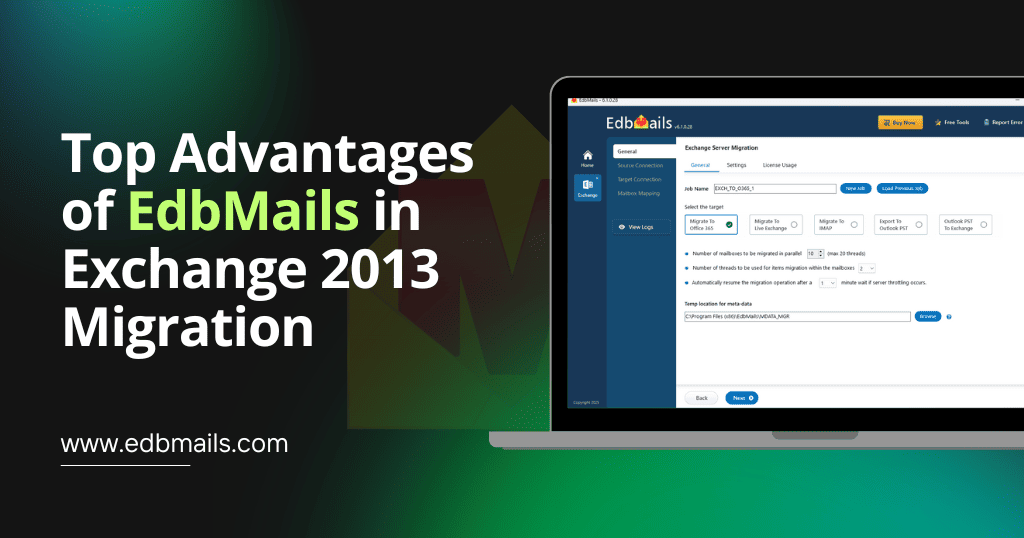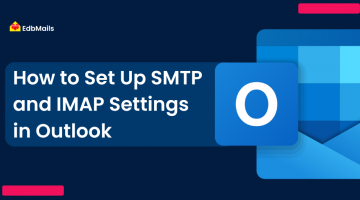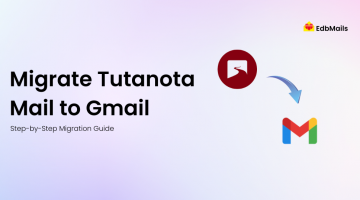Exchange 2013 To 2016 Migration
Exchange 2013 to 2016 migration involves moving mailboxes, emails, contacts, calendars, and other data from an Exchange 2013 server to Exchange 2016. This process ensures that organizations benefit from enhanced performance, improved security, and new features offered by Exchange 2016, while maintaining data integrity and minimal downtime. Proper planning, backup, and the use of reliable migration tools, like EdbMails, can simplify the transition and prevent data loss.

Why You Should Migrate from Exchange 2013
Running Exchange 2013 may be putting your organization at risk. Microsoft has stopped providing upgrades, bug fixes, and security updates for this legacy version, leaving servers vulnerable to attacks and potential data loss.
Migrating to Exchange 2016 not only strengthens your server’s security but also unlocks the latest features and performance improvements. It’s the ideal way to keep your infrastructure up-to-date, stable, and easier to maintain.
Additionally, native migration tools from Microsoft can be complicated and time-consuming, often requiring extensive PowerShell scripting. Using a trusted solution like EdbMails simplifies the process, ensuring a smooth, secure, and efficient migration without any disruption to your business.
New Updates and Features in Exchange Server 2016
Exchange Server 2016 comes with several improvements over previous versions, making email management more efficient, secure, and user-friendly. Some key updates and features include:
- Simplified Architecture: Exchange 2016 combines the Client Access and Mailbox server roles, reducing complexity and improving performance.
- Improved Outlook Web Access (OWA): A more modern, responsive interface with enhanced features like easier calendar management and better mobile compatibility.
- Enhanced Search Capabilities: Faster and more accurate search across mailboxes, making it easier to find emails, contacts, and attachments.
- Data Loss Prevention (DLP): Protects sensitive information by identifying, monitoring, and restricting the sharing of confidential data.
- Better Compliance Tools: Advanced auditing, eDiscovery, and retention policies help organizations meet regulatory requirements.
- Faster Mailbox Management: Improved database availability groups (DAGs) and performance enhancements allow smoother mailbox operations and migrations.
- Hybrid Deployment Support: Simplified integration with Exchange Online for organizations moving toward a hybrid cloud environment.
EdbMails: The Complete Exchange 2013 to 2016 Migration Tool
The EdbMails Exchange Server Migration tool is designed to make upgrading from Exchange 2013 to 2016 smooth and worry-free. It enables direct migration of mailboxes, emails, calendars, contacts, and attachments without requiring complex PowerShell scripting.
With features like selective mailbox and folder migration, filter options, and true incremental migration to prevent duplicates, the tool ensures maximum efficiency. Its automatic reconnection and auto-mapping capabilities handle technical complexities in the background, letting administrators focus on the migration rather than troubleshooting.
EdbMails Exchange Server Migration tool not only guarantees data integrity and security but also minimizes downtime, making it one of the most reliable solutions for organizations moving from Exchange 2013 to 2016.
👉🏻 Explore the step-by-step guide for Exchange 2013 to 2016 migration using EdbMails.
How EdbMails Simplifies Exchange 2013 to 2016 Migration
EdbMails makes migrating from Exchange 2013 to 2016 simple, secure, and efficient. Here’s how it helps:
- Direct Migration: Move mailboxes and data directly from Exchange 2013 to 2016 without intermediate steps.
- Selective Migration: Migrate only specific mailboxes, folders, or items using the built-in filter options.
- True Incremental Migration: Avoid duplicates by migrating only new or changed items.
- Automatic Reconnection: The tool reconnects automatically in case of any connection interruptions, ensuring smooth migration.
- Auto Mapping: Source mailboxes are automatically mapped to the corresponding target mailboxes for a hassle-free migration.
- User-Friendly: EdbMails provides a simple and straightforward interface, making Exchange 2013 to 2016 migration easy for IT teams.
Using EdbMails ensures a reliable, fast, and secure migration while maintaining complete data integrity, minimal downtime, and a smooth transition to Exchange 2016.
Conclusion
Migrating from Exchange 2013 to 2016 is more than just an upgrade—it’s a step toward better performance, stronger security, and modern features that keep your business running smoothly. While the native migration process can be complex and time-consuming, the EdbMails Exchange Server Migration tool eliminates these challenges by offering direct, secure, and user-friendly migration with minimal downtime.
With advanced features like incremental migration, selective mailbox transfer, auto-mapping, and automatic reconnection, EdbMails ensures that your data is fully protected and the transition is seamless. For organizations looking to move from Exchange 2013 to 2016 with confidence, EdbMails provides the most reliable and efficient solution.
See More
🔗 Why EdbMails Office 365 Migration is secure?
🔗 Exchange 2007 to 2013 Migration: The Why and How



